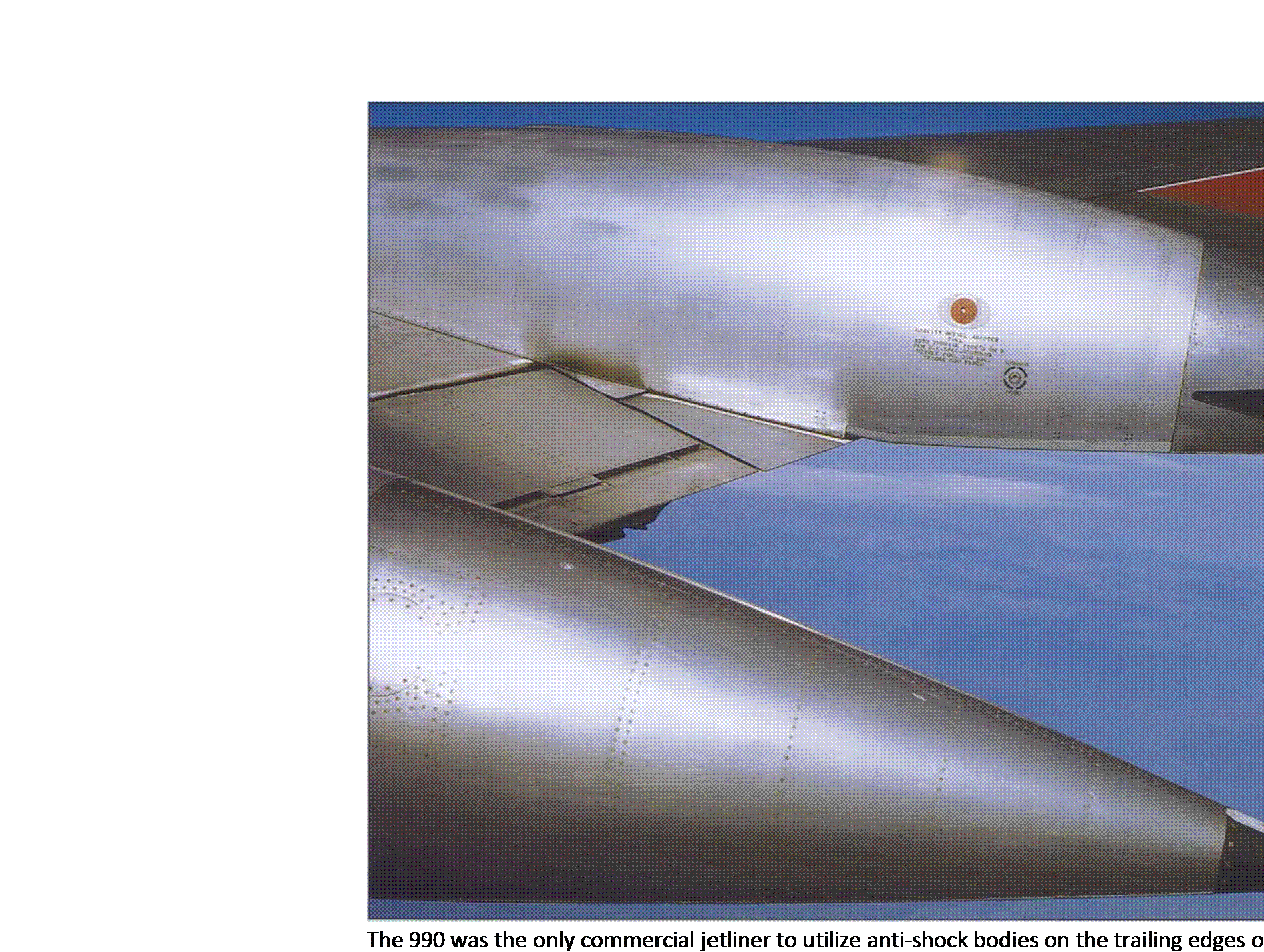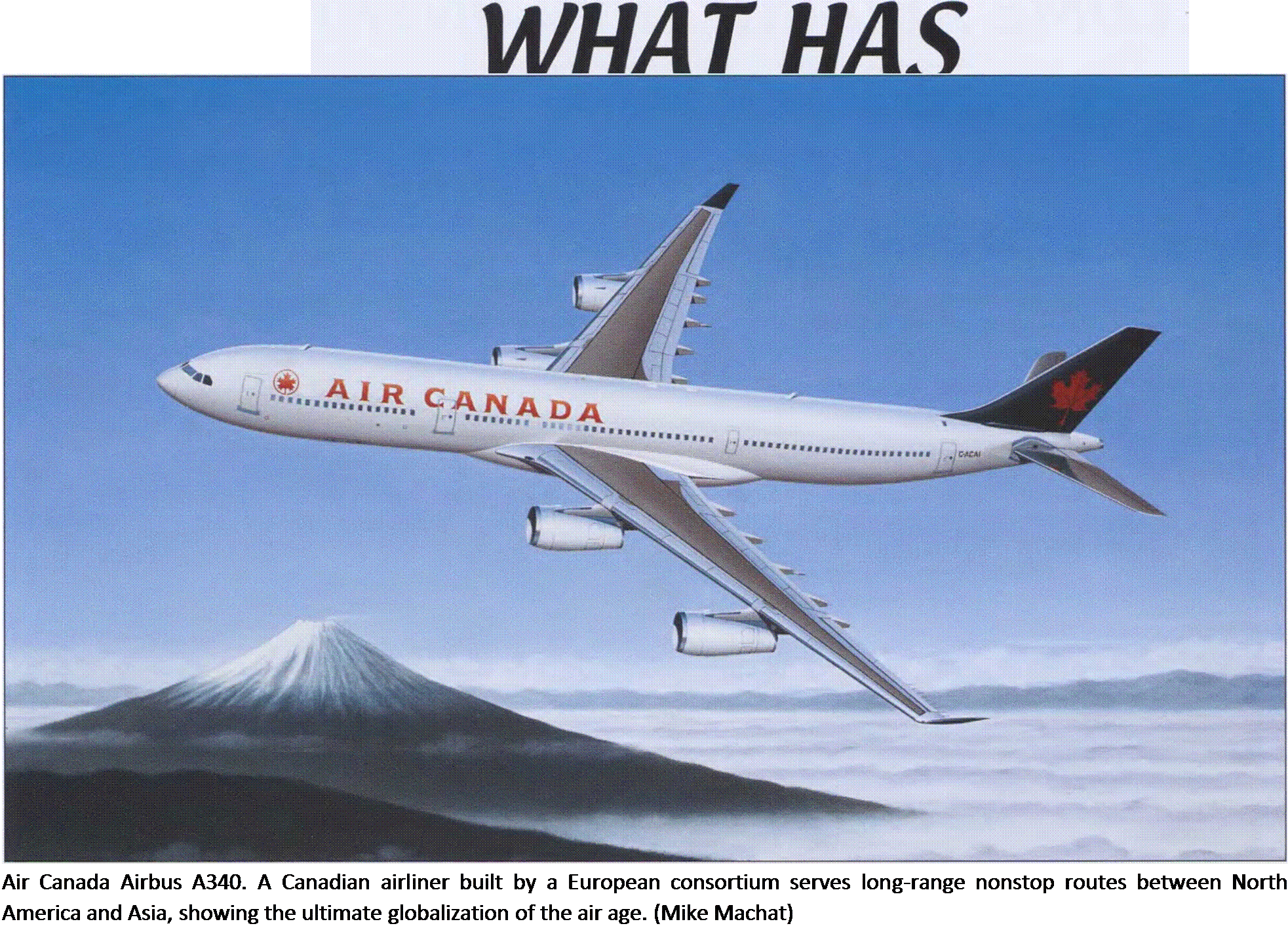WELCOME ABOARD THE CONVAIR 990
 |
By Mike Machat
The differences in this airplane become apparent even before you enter the cabin, for the door is shaped unlike any other in the world. Vertically straight on the left side, but tapered-in on the right, this windowless device is a marvel to behold.
Walking down the aisle to your seat, you notice the coach cabins five-across seating configuration. As with the Convair 880, it’s two on one side and three on the other —a configuration that won’t be seen in other jetliners until the Douglas DC-9 enters service in 1965. Taking your seat just aft of the wing you look out the window and can’t help but notice the 990’s sleek and curvaceous “speed pods” mounted on the wing’s inboard trailing edge. With the engines now started and whining in unison, the ground tug pushes your airplane back from the gate, and then the magic of this machine becomes readily apparent.
The somewhat firm ride while taxiing is more reminiscent of Convair’s B-58 Hustler supersonic bomber. Like driving a Ferrari in second gear, you can’t help but sense the potential performance of this airplane. Taking the runway, the captain pushes the thrust levers to their stops and nearly 65,000 pounds of thrust from four General Electric turbofans sends you bounding down the concrete in what feels more like a takeoff in a jet fighter. You notice the look of surprise on the faces of your fellow passengers as the 990 rotates smartly and climbs at a somewhat steeper angle than that “straight-pipe” 707 you flew on last time.
With flaps and slats retracted, the 990 now climbs swiftly to its cruising altitude. Soon the wind noise from the outside air rushing by your window at more than nine-tenths the speed of sound tells you that you’re indeed flying aboard the fastest jetliner in the skies.
|
O |

ur story ends in 1962 as intercontinental jetliners reach maturity, but commercial aviation continued to develop for many years thereafter. Smaller “regional” jetliners, larger “wide-body” jetliners, and even supersonic jetliners all took to the skies by the end of that decade. Perhaps the most graphic change in the industry is evident in the number of American airliner manufacturers. Of the five companies building commercial airliners in the United States at the beginning of our story, only one remains in business today.
Although our story ends with the introduction of larger and more refined fanjet-powered airliners, the continued evolution of air travel in the Jet Age bears mention as a fitting and proper ending to this book. By the end of the twentieth century, the airline industry had transformed itself from a “higher, faster, farther”
mentality to a “less is more” frame of mind. The proud post-World War II generation who led the endless quest for greater speed, range, power, and passenger capacity gave way to a more modern group of industrial thinkers who toiled to bring less operating cost, less fuel consumption, and less noise and pollution to the world at large. By the turn of the century, the torch of progress had been passed to a new digital generation of airliner builders and operators, although their numbers were definitely fewer than before.
Former titans of the airline industry who were pilots themselves or “airplane people” as well as businessmen, had also been replaced by a new breed of generic corporate leaders armed with MBAs and fiscal management skills that fit the newly homogenized corporate culture running rampant throughout the airline
world and the world at large. Indeed, the only constant in this beloved industry became change itself. On the airframe and engine manufacturing side of the ledger, a myriad of companies worldwide began merging into seemingly unidentifiable corporate conglomerates. By the mid-1960s, proud names like Martin and Convair were gone, and other once-untouchable companies like Douglas and Lockheed were suddenly pushed to the edge of financial oblivion.
Pummeled by manufacturing problems and production delays exacerbated by jet-engine deliveries being diverted for the rapidly growing war in Vietnam, the Douglas Aircraft Company merged in a “shotgun wedding” with military manufacturer McDonnell in April 1967. Lockheed, whose turboprop Electra effectively bridged the gap from props to jets, was kept afloat until the advent of its L-1011 Trijet, bolstered through the lean years only by the company’s successful military business. The biggest surprise, however, was that Boeing, once the undisputed underdog in the airliner manufacturing world, had now risen to the top of the pyramid by virtue of its undeniable success with the 707 series. This pioneering airplane sired an entire family of new jetliners, large and small, each one breaking barriers and establishing jet passenger service in new ways.
In October 1978, the Airline Deregulation Act was signed into law by then-U. S. President Jimmy Carter. This well-intentioned piece of legislation quickly turned the airline world on its proverbial ear. Although the noble intent was to lift restrictions on domestic routes and airfares, thus encouraging healthy competition, the result was rampant, unbridled route expansion, an explosion of new upstart carriers, and the end of many established airlines, all happening at unprecedented speed and on an unprecedented scale. The David-and-Goliath success story of tiny Southwest Airlines emerging as an industry giant was also written (although the carrier began operations in 1971), as it continued to thrive despite the challenges posed by Deregulation. However, there were many more tales of sordid failure as countless new upstarts tried to emulate Southwest’s unique business model with little success.
America’s domestic trunk airlines began to stumble while trying to compete on newly acquired overseas routes purchased from struggling Pan American World Airways —the same company once proudly called “The Chosen Instrument.” By the end of the century, Pan Am, along with Braniff, Eastern, National, Western, and more than 100 regional and local airlines no longer existed, having been either merged into other carriers or plunged into bankruptcy and oblivion. TWA held on valiantly but then disappeared in 2001, with pieces of the company having been purchased by American Airlines. Today, only American, United, Continental, and Delta remain as the surviving U. S. “legacy carriers,” with Northwest —itself an amalgamation of older airline names —being merged into Delta as this book is being written.
In the late-1970s, a grim undercurrent also began to appear on the domestic airline scene with insidious acts of violence involving commercial aircraft. The casual inflight atmosphere of friendly visits to open cockpits and captains strolling down cabin aisles personally greeting passengers came to an end. Even airport access where a young wide-eyed kid could hang on a chain – link fence or stand on a sweeping observation deck was slowly replaced by a darker “future shock” world of beeping metal detectors, barbwire fences, and alarmed terminal doors. Back in the 1950s, a sinister wave of airliner hijackings and inflight bombings to collect passengers’ life insurance swept the industry, but by the 1980s, a number of U. S. airline flight-crew members had been tragically shot inflight with the resultant loss of their airplanes and all the innocent passengers onboard.
Although violent hijackings and airliner losses from terrorist bombings had occurred overseas, the first subtle hint of international terrorism reaching U. S. shores appeared with a deadly bombing at New York’s LaGuardia Airport Terminal at Christmastime 1975, when members of an Eastern-European political sect hid timed explosives in a public baggage locker. By the late – 1990s, both Pan Am and Air India had lost Boeing 747s to explosive devices hidden in luggage containers with the loss of all onboard. Then, on a bright, clear September morning in 2001, the unthinkable happened as a stunned world witnessed on live television hijacked operational airliners being used as terrorist weapons for the first time in history. Three were flown into buildings and one crashed short of its intended target, but after the tragedy of September 11, the airline world —and the world in general—would never be the same again.










